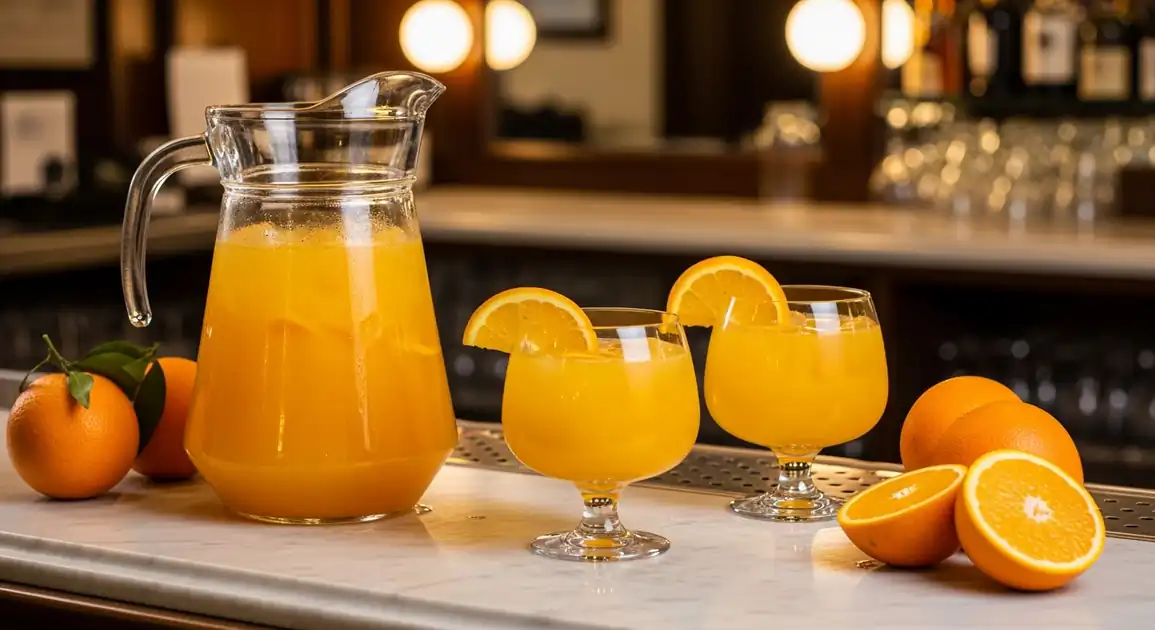Agua de Valencia (Valencian Water Cocktail)
Agua de Valencia

Description
Valencia is the definitive home of Agua de Valencia. It's readily available and widely consumed in countless bars, cafes, and restaurants across the city, from historic spots like Cafe Madrid de Valencia to modern terraces and neighborhood bars. Trying it here is a quintessential Valencian experience.
Dietary Information
Serving information
Serving style
Most commonly served by the pitcher ('jarra') for groups, but also available by the glass ('copa'). Served chilled in wide cocktail glasses, garnished with an orange slice.
Quick facts
Bars open from late morning/midday until very late (1 AM - 3 AM or later).
Safety Tips
What to Look For
-
Made with freshly squeezed orange juice ('zumo natural')
Ensures best flavor and quality. Avoid places using bottled or concentrated juice.
-
Served well-chilled
The cocktail should be very cold for optimal taste and refreshment.
-
Prepared in a clean bar environment
Good hygiene practices by the staff and clean serving ware are essential.
-
Transparent pricing
Prices per glass and pitcher should be clearly indicated on the menu.
-
Balanced flavor profile
A well-made version shouldn't taste overwhelmingly of cheap alcohol; the orange and Cava should shine.
What to avoid
-
Drinking excessively due to deceptive taste
The sweet, fruity flavor masks the high alcohol content. Pace yourself and be aware of its strength.
-
Suspiciously cheap offers
Extremely low prices might indicate use of low-quality spirits, artificial juice, or improper preparation.
-
Places using bottled or artificial orange juice
Significantly impacts the authentic flavor and quality.
-
Pre-mixed batches sitting out at room temperature
Best prepared fresh or kept well-chilled before serving.
-
Drinking on an empty stomach
Consuming food alongside helps manage the alcohol effects.
Price information
Price range
Budget tips
- Price per glass ('copa') is usually €4-8.
- Pitchers ('jarras') for sharing cost around €15-25 and are more economical for groups.
- Prices might be slightly higher in prime tourist spots (e.g., near the Cathedral) than in local neighborhoods.
- Some bars offer it as part of a drinks deal.
Value indicators
- Guaranteed use of fresh Valencian orange juice.
- Often made with local Cava.
- Authentic recipe proportions.
- Served widely and understood by all bartenders.
Where to Find This Dish
El Carmen
The historic old town is filled with traditional and modern bars serving Agua de Valencia.
Plaza de la Virgen, Plaza del Negrito, Calle Caballeros
Afternoon, Evening, Night
Ruzafa (Russafa)
Trendy neighborhood known for its vibrant nightlife and numerous bars and cafes.
Mercado de Ruzafa area, Calle Cádiz
Afternoon, Evening, Night
Canovas
Another popular area for bars and restaurants, known for its lively atmosphere.
Plaza Cánovas del Castillo
Evening, Night
Near City of Arts and Sciences
Modern bars and restaurants in the vicinity also offer the drink.
Shopping centers near CAC
Afternoon, Evening
Cafe Madrid de Valencia
The birthplace of the cocktail, a historic spot to try the original.
Near Plaza del Ayuntamiento
Afternoon, Evening
Vendor Tips
- Always specify 'zumo natural' if you want to be absolutely sure about fresh juice.
- Ordering a 'jarra' is the most traditional way for groups.
- Many places have their 'secret' slight variations; try a few spots!
- Enjoy the social atmosphere often associated with sharing a pitcher.
How to Order
Regional Variations
-
House Recipes
(Recetas de la Casa)
While the core ingredients are consistent, nearly every bar has its own subtle tweak to the ratios or sweetness.
Cultural context
History
The cocktail was created in 1959 at the Café Madrid de Valencia (which still exists) by its owner, Constante Gil. Initially made for a group of Basque travelers tired of ordering their usual drinks, it remained a local secret for years before gaining wider popularity in Valencia during the 1970s nightlife scene. It's now considered an emblematic drink of the city.
Local significance
Agua de Valencia is more than just a drink; it's a symbol of Valencian social life, hospitality, and local pride in its oranges and Cava.
Eating customs
- Typically shared among friends from a pitcher.
- Sipped and enjoyed over conversation.
- Consumed year-round, regardless of the weather.